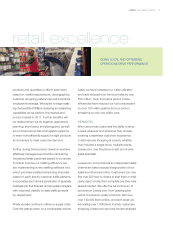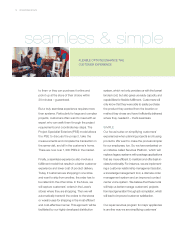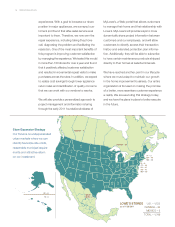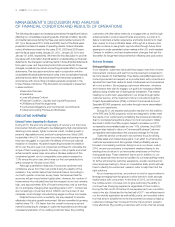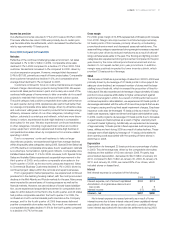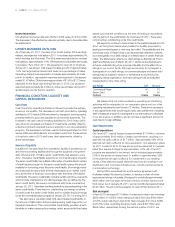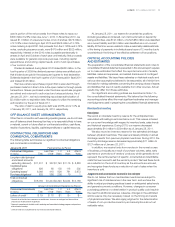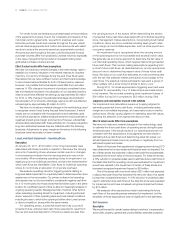Lowe's 2010 Annual Report Download - page 27
Download and view the complete annual report
Please find page 27 of the 2010 Lowe's annual report below. You can navigate through the pages in the report by either clicking on the pages listed below, or by using the keyword search tool below to find specific information within the annual report.
LOWE’S 2010 ANNUAL REPORT 23
used a portion of the net proceeds from these notes to repay our
$500million8.25%notesdueJune1,2010.InNovember2010,we
issued$1.0billionofunsecurednotes,intwotranches:$475million
of2.125%notesmaturinginApril2016and$525millionof3.75%
notes maturing in April 2021. Net proceeds from the 2.125% and 3.75%
notes,excludingissuancecosts,were$473millionand$522million,
respectively. Interest on the 2010 notes is payable semiannually in
arrears in April and October of each year until maturity. Net proceeds
were available for general corporate purposes, including capital
expendituresandworkingcapitalneeds,andtofundrepurchases
of our common stock.
Dividendsdeclaredduringscal2010totaled$588million.Inthe
fourth quarter of 2009 the dividend payment dates were shifted such
that dividends are paid in the subsequent quarter to their declaration.
Dividends declared in the fourth quarter of 2010 were paid in fiscal 2011
andtotaled$148million.
Wehaveasharerepurchaseprogramthatisexecutedthrough
purchases made from time to time in the open market or through private
transactions. Shares purchased under the share repurchase program
are retired and returned to authorized and unissued status. As of
January 28, 2011, we had a remaining repurchase authorization of
$2.4billionwithnoexpirationdate.Weexpecttoutilizetheremaining
authorization by the end of fiscal 2011.
The ratio of debt to equity plus debt was 26.6% and 21.0% as
of January 28, 2011, and January 29, 2010, respectively.
OFF-BALANCE SHEET ARRANGEMENTS
Otherthaninconnectionwithexecutingoperatingleases,wedonothave
any off-balance sheet financing that has, or is reasonably likely to have,
amaterial,currentorfutureeffectonournancialcondition,cashows,
resultsofoperations,liquidity,capitalexpendituresorcapitalresources.
CONTRACTUAL OBLIGATIONS AND
COMMERCIAL COMMITMENTS
The following table summarizes our significant contractual obligations
and commercial commitments:
January 28, 2011 Payments Due by Period
Contractual Obligations Less Than 1-3 4-5 After 5
(In millions) Total 1 Year Years Years Years
Long-term debt (principal
and interest amounts,
excludingdiscount) $11,517 $ 332$1,190 $1,115 $ 8,880
Capitalized lease
obligations1 626 68 138 118 302
Operating leases1 6,008 418 826 791 3,973
Purchase obligations2 633 386 236 10 1
Total contractual
obligations $18,784 $1,204$2,390 $2,034 $13,156
AmountofCommitmentExpirationbyPeriod
Commercial Commitments Less Than 1-3 4-5 After 5
(In millions) Total 1 Year Years Years Years
Letters of credit 3 $ 19 $ 18 $1 $– $–
1 Amounts do not include taxes, common area maintenance, insurance or contingent rent because these
amounts have historically been insignificant.
2 Represents commitments related to certain marketing and information technology programs and purchases
of merchandise inventory.
3 Letters of credit are issued primarily for real estate and construction contracts.
AtJanuary28,2011,ourreserveforuncertaintaxpositions
(including penalties and interest), net of amounts held on deposit by
taxingauthorities,was$123million,ofwhich$80millionwasclassied
asacurrentliabilityand$43millionwasclassiedasanon-current
liability. At this time, we are unable to make a reasonably reliable estimate
of the timing of payments in individual years beyond 12 months due to
uncertaintiesinthetimingoftheeffectivesettlementoftaxpositions.
CRITICAL ACCOUNTING POLICIES
AND ESTIMATES
The preparation of the consolidated financial statements and notes to
consolidated financial statements presented in this annual report requires
us to make estimates that affect the reported amounts of assets,
liabilities,salesandexpenses,andrelateddisclosuresofcontingent
assets and liabilities. We base these estimates on historical results and
various other assumptions believed to be reasonable, all of which form
the basis for making estimates concerning the carrying values of assets
and liabilities that are not readily available from other sources. Actual
results may differ from these estimates.
Our significant accounting policies are described in Note 1 to
the consolidated financial statements. We believe that the following
accounting policies affect the most significant estimates and manage-
ment judgments used in preparing the consolidated financial statements.
Merchandise Inventory
Description
We record an obsolete inventory reserve for the anticipated loss
associated with selling inventories below cost. This reserve is based
on our current knowledge with respect to inventory levels, sales trends
andhistoricalexperience.During2010,ourreservedecreased
approximately$10millionto$39millionasofJanuary28,2011.
We also record an inventory reserve for the estimated shrinkage
between physical inventories. This reserve is based primarily on actual
shrinkage results from previous physical inventories. During 2010, the
inventoryshrinkagereservedecreasedapproximately$11millionto
$127millionasofJanuary28,2011.
In addition, we receive funds from vendors in the normal course
of business, principally as a result of purchase volumes, sales, early
payments or promotions of vendors’ products, which generally do not
represent the reimbursement of specific, incremental and identifiable
costs that we incurred to sell the vendor’s product. We treat these funds
as a reduction in the cost of inventory as the amounts are accrued,
and recognize these funds as a reduction of cost of sales when the
inventory is sold.
Judgments and uncertainties involved in the estimate
We do not believe that our merchandise inventories are subject to
significant risk of obsolescence in the near term, and we have the
ability to adjust purchasing practices based on anticipated sales trends
and general economic conditions. However, changes in consumer
purchasing patterns or a deterioration in product quality could result in
the need for additional reserves. Likewise, changes in the estimated
shrink reserve may be necessary, based on the timing and results
of physical inventories. We also apply judgment in the determination
of levels of non-productive inventory and assumptions about net
realizable value.


